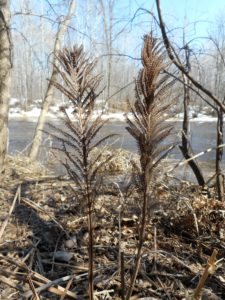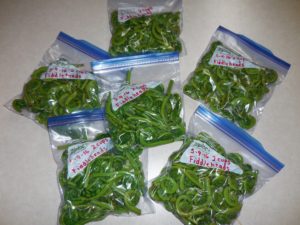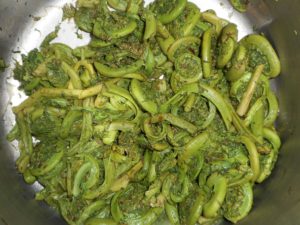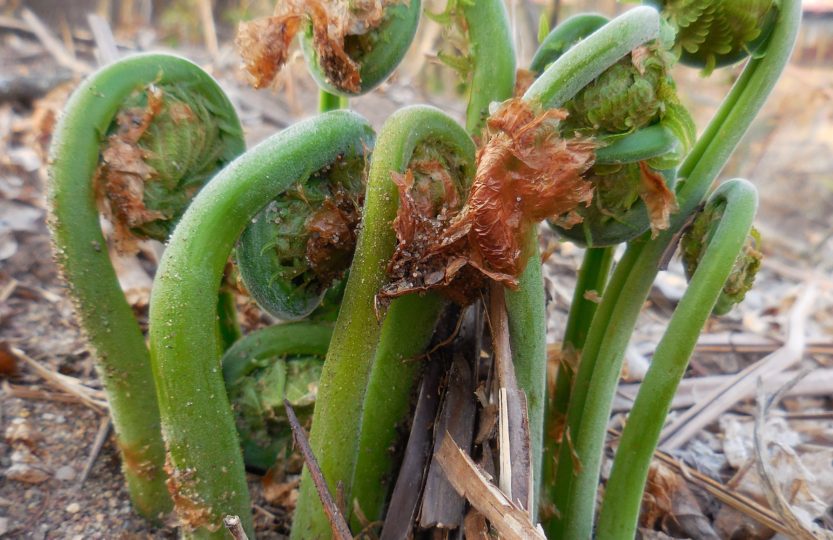It’s fun to have your own family, foraging traditions. Every year, my family and I have a special place by the river where we go spring foraging. Our favorite wild edibles along the riverbank are the fiddleheads of Ostrich Fern, Matteucia struthiopteris. We head out to the river right around the time the leaves start leafing out to do our annual fiddlehead harvest. They are harvestable from early to later May in Minnesota where I live. You can harvest fiddleheads until all the fronds have unfurled. Some people like to take a fiddlehead for a trail-side nibble, but others caution against eating them raw. Personally, I always thoroughly cook them and would advise properly cooking them to avoid getting sick. I’ll give you a simple recipe later in this post! Fiddleheads are delicious. Their taste tends to be compared to asparagus. I’d have to say that I like the taste of them a lot more than asparagus, but I do see the similarities.
How do you Identify Ostrich Fern?
First, let’s explore what not to look for, and then, I’ll describe the characteristics of the fiddleheads you want to be looking for. Not all fiddleheads are edible. Once you’re familiar with Ostrich fern, you should have no trouble telling it apart from other ferns that have a fiddle-like appearance to their shoots. The two look-a-likes that you want to stay clear of are Cinnamon Fern, Osmunda cinnamomea, and Interrupted Fern, Osmunda claytonia. There are other ferns that send up fiddleheads, too, but Cinnamon Fern and Interrupted Fern are the most confused. The differences are very apparent. Both are covered with wool. Do not harvest fiddleheads that are wooly. You could get very sick.


There are two main characteristics of Ostrich Fern which set these fiddleheads apart from others. First, it has U-shaped stems. Look at the above picture of Ostrich Fern on the left. They are smooth, green and celery shaped. Second, brown, paper-like scales cover the tops of the fiddleheads. Sometimes, a white powdery substance covers the tops, also, but not always. These characteristics are distinguishing features. Remember, Ostrich Fern is NOT wooly. The shoots of Ostrich Fern come up in a rosette around the brown, dried up fertile fronds from the year before. In early spring, these brown, dried up structures are a giveaway as to where the fiddleheads will be shooting up in your neck of the woods. The above picture on the right shows these fertile fronds. Keep your eyes on the look-out for them along riverbanks or in moist, rich woods by the shores of ponds or marshes. They tend to grow in disturbed areas prone to erosion. Here is a USDA map that shows Ostrich Fern distribution. If you click on your state, you can zoom in to your county.
How do you Sustainably Harvest Fiddleheads?
* The decision to harvest any plant is one that only you can make. You are solely responsible for your own decisions in doing so. Thoroughly researching, cross-checking your identification, and verifying it with a professional is a wise decision. Always familiarize yourself with potential look-alikes, potential side-effects, and any herbal cautions that may apply to the wild food you are interested in harvesting. As writer of this blog, I hold no liability for your decision. I only share my own personal experiences and knowledge. Use utmost caution in your choice to harvest any wild food. If you choose to make the harvest, that is your own personal decision.
Always think about harvesting sustainably when you are out foraging. These are gifts. We have a lot to be thankful for. Give thanks in a good way and ask permission to harvest in your own way. Only harvest what you can use and never take more than is sustainable. Be wise! For fiddleheads, I stick to the rule that Sam Thayer discusses in his book, the Foragers Harvest. He says to only harvest 2 out of 5 fronds or 3 out of 6 never returning to the same rosette in a given year. Using scissors or snapping off the fiddleheads, harvest the uncurled top along with the straight part of the stem down to the point that it gets tougher.
Some people choose to only harvest the curled up part of the fiddlehead. This leads to a lot of wasted potential of the shoot in my opinion. I harvest about 6 inches or more down from the fiddle-head depending on the height of the shoot. The stem is tougher towards the bottom, so make your cut or snap it before the tough section. Harvesting in a manner where you don’t get dirt all over your fiddleheads is also a good thing to do. There is a lot of places for dirt to get stuck on the curled up tops making it difficult to rinse off.
How do you Preserve and Prepare Fiddleheads?
Freezing Fiddleheads
The area my family forages fiddleheads in the spring is abundant. We sustainably harvest enough to freeze for use throughout the year. Here’s the process we use. Frozen, Fiddleheads will keep for up to a year.
- Rinse your fiddleheads well removing the paper-like scales.
- Bring a 2 quart pot of water to a rolling boil. Plan to blanch a few batches, doing a small amount each time.
- Once boiling, carefully drop in your fiddleheads and return it to a boil. Blanch for 2 minutes.
- Strain the fiddleheads and rinse in a tub of water and ice.
- Drain, blot with paper towels, and freeze in Ziploc baggies labeled and dated.
- Enjoy your fiddleheads year round! Thaw in the refrigerator or cool water and cook properly.


Family’s Favorite Fast Food Fiddleheads
There are a lot of recipes for fiddleheads out on the web and in forager’s cookbooks. Doing a search on the internet will land you with a variety of ways to prepare fiddleheads. I’ll leave you with my family’s favorite way of cooking them up for a quick, simple side to a meal. Remember that allergies can happen with any new food. Try only a small amount when first consuming any new, wild food.
- Rinse your fiddleheads to remove any possible dirt. We usually use about 2 cups of fiddleheads for a family meal.
- Bring a 2 quart pot of water to a boil. Carefully, drop in the fiddleheads returning it to a boil.
- Let the fiddleheads boil for approximately 15 minutes. Then, strain.
- Next, sauté the fiddleheads in some butter with a little salt and pepper. You can also add other herbs to your liking or get creative with other additions. Wild Leek is delicious to add if you happen to chance upon a good ramp patch. Sometimes, you’ll find Wild Leek growing alongside Ostrich Fern. Make sure to check out my post on Exploring Wild Leek: ID, Harvest, and Prep. before you head out on the trail. Chances are you may run into some Wild Leeks along your path!
It is important that you properly cook fiddleheads. You can either boil them with the above method or choose to steam instead for 10-12 minutes. Get creative and have fun trying fiddleheads as additions to soups, vegetable dishes, or other recipes. Cook them properly prior to adding them.
Have you Checked out the New Products at Nature Art Exploration?
Nature Art Exploration is starting to add a few new, affiliate products to the shop that can aid you in some of the explorations here. Check out the great books by Sam Thayer while you’re there! The Forager’s Harvest DVD is also excellent. It has over 3 hours of instruction covering all 32 plants that were covered in his Forager’s Harvest book (including Fiddleheads). I continually return to these books, and the DVD as references.
*This post contains affiliate links. A small percentage of all the purchases you make by following the above links will help support this site. Thank you for choosing to support Nature Art Exploration!*
Thank you for joining Nature Art Exploration in getting excited about spring foraging. I hope you find some fiddleheads with your family this year. Remember to always harvest sustainably and tread lightly on the earth! Please, share in below with any questions, thoughts, or other comments. Nature Art Exploration loves hearing from you!






